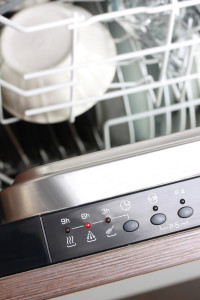Household Appliances (Part One)

Over the next couple of postings we’ll present some general guidelines for the operation and maintenance of various household appliances. For the most part, it will be basic information, much of which will already be known to many. That said, there may be nuggets of new, useful stuff or reminders of good practices that will be helpful. In the event of conflict between our guidelines and those of equipment manufacturers, the manufacturer’s guidelines or requirements should prevail. The first part of the series covers dishwashers and garbage disposers.
 Dishwashers connect by flexible hoses to garbage disposers through backflow preventers (air gaps), which are normally mounted on the tops of sinks. They’re employed to prevent waste water in sinks from entering and contaminating the dishwashers. Deposits (detergent residue, dissolved fats, etc.) can accumulate in the hose or disposer connection and impede water flow. If you’ve ever noticed water emitting from openings in an air gap cover, it’s a safe bet there’s an obstruction and it’s likely to be at or near the disposer connection. Obstructions can occur at any time, so the covers should be turned to disgorge water into the sink.
Dishwashers connect by flexible hoses to garbage disposers through backflow preventers (air gaps), which are normally mounted on the tops of sinks. They’re employed to prevent waste water in sinks from entering and contaminating the dishwashers. Deposits (detergent residue, dissolved fats, etc.) can accumulate in the hose or disposer connection and impede water flow. If you’ve ever noticed water emitting from openings in an air gap cover, it’s a safe bet there’s an obstruction and it’s likely to be at or near the disposer connection. Obstructions can occur at any time, so the covers should be turned to disgorge water into the sink.
Obstructed connections should be cleaned. One cleaning method would be to scour the opening and nearby section of hose with an appropriately sized, flexible bottle brush. The opening can be felt from the inside of the disposal and is usually just under three-quarters of an inch in diameter. The dishwasher should be set to fill and then discharge during, or immediately after brush cleaning in order to flush particles dislodged by brushing.
Only dishwasher detergent should be used in dishwashers. Liquid dish soap produces excessive suds in a dishwasher and the increase in volume can cause leakage around door gaskets. Furthermore, soap suds cannot be effectively pumped and can remain in the tub after completion of rinse cycles. Moreover, dishwasher detergent is far stronger and therefore more effective than liquid soap.
Disposers can experience leakage problems that can go undetected without periodic inspection. Some disposers (particularly lower-cost units manufactured of painted carbon steel) can rust through within as few as three to five years. Stainless-steel units tend to be longer-lived. The disposals should be visually inspected periodically, at intervals appropriate to age and quality. Older low-quality units should be inspected monthly for visible corrosion (rust) and active leakage.
In addition to corrosion/leakage concerns, disposers vary in duty rating and misuse can result in drainage obstructions or other problems. Manufacturer’s recommendations should be followed with respect to materials their devices can process. As a general rule, grease/fats should not be poured into sinks. Grease (melted fat) will coagulate and coat drain lines and can impede drainage enough to cause sewer backups. Some items (such as carrot peelings) can pass relatively intact through some disposals and accumulate in traps and lines.
Caustic drain cleaners should not be used in garbage disposals. Such materials can corrode metal and degrade seals or other components essential to operation and watertight integrity.
